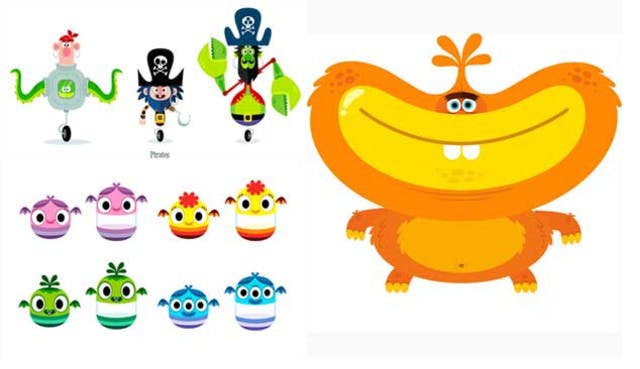Coming soon to an iPad near you… Teach Your Monster to Read: First Steps goes mobile!
With all the same functionality and features that your little monsters loved about the online game, this iPad version will be just as fun and educational, helping young children to practise the initial steps of reading.
Teach Your Monster to Read: First Steps is built on the principles of synthetic phonics and follows the teaching sequence in the “Letters and Sounds” programme
The game develops children’s speed and accuracy of letter recognition by taking them on a fantastic adventure through a magical world where they meet island kings and collect letters to win prizes. It also explores blending and segmenting, and introduces “tricky” words in a fun, interactive setting. It is aimed at beginning readers, both those who are on track and those who need more support.
Teach Your Monster to Read: First Steps app features the voice of Simon Farnaby from BBC’s Horrible Histories.
To register your interest in hearing about the Teach Your Monster to Read: First Steps please email us.

This Summer, join the monster on his new adventure with Teach Your Monster to Read: Fun With Words.
Designed for children who have already mastered our first game, in Fun With Words, the monster will continue his journey through a spectacular new kingdom of hidden treasure, balloon flights and spaceship rides!
Meeting new characters along the way, such as the Hungry Word Beast, the Space Pirates and the naughty “Trickies”, the monster has been set the task of finding his way home once again. Throughout his adventure, the monster will collect gold coins which can be exchanged for fantastic prizes.
The game will introduce further graphemes and phonemes. There’ll be lots of tricky word practice, plus more blending and segmenting. The students will also be given the chance to practise blending when reading basic captions and sentences. This new game complements Letters and Sounds up to the end of Phase 4.
For updates about the launch of Teach Your Monster to Read: Fun With Words, join our Facebook group or follow us on Twitter. Alternatively email our Community Manager dannie@teachyourmonstertoread with ‘Game 2’ as the subject.
This article is written by Mara Dettmann, a freelance writer based in Paris where she runs http://www.the-continentalist.com
I stumbled across TYMTR while browsing Usborne’s website for educational kids’ books back in mid-February – and Lee, my three-and-a-half-year-old daughter, was captivated from the start.
First, some background on our situation: I’m German and my husband’s British; Lee spent the first three years of her life in the UK (where she went to a British childminder and nursery) but is now attending a German preschool. Though I’m hoping for Lee to be fully bilingual I also want her English to progress at native-speaker level – especially since she’s (re-)entering the British educational system this fall.
How we use TYMTR
TYMTR has become a firm part of our evening routine, and Lee has become quite attached to her monster and its adventures.
If it were up to Lee, she’d play the game hours on end – but to ensure the information sticks to her long-term memory and limit her screentime I keep it at one letter a day. If I think she needs additional practice with a letter I quit the game before her monster gets her prize, so she has to review it again the next day. She is not a fan of this technique and protests heavily, but it does help.
As far as I can see, Lee learns the most from the princess minigame. Flowers and factory are too fast-paced for her – though playing the game has definitely improved her cursor skills – while sheep and aliens don’t really challenge her any more. Initially, Lee needed my help in understanding what exactly she had to do; now, she goes through the game independently (though I still supervise).
Supplemental tools for early literacy development
For us, TYMTR is part of a bigger home learning project to instil a general love for learning within Lee, in the languages, maths and sciences alike.
Specifically for her English literacy skills, we read a lot – bedtime includes at least four picture books. Lee’s a big fan of dinosaurs and lift-the-flap books, so one of her favourites is Usborne’s See inside the world of dinosaurs
After our daily TYMTR session, Lee will normally finish her screentime with a few educational music videos – she especially likes They Might Be Giants kids’ songs. From Here come the ABCs she currently likes best ‘The alphabet lost and found’ and ‘D and W’.
When we’re out and about, we also make a point of talking to her about the letters and numbers that surround us – mostly on billboard posters, sometimes on license plates (less fun since you can’t sound out the letters into words). Most recently, I’ve started making flashcards that have a word on one side and its picture on the other, with which we play to make simple sentences – like ‘the dog is small’.
We practice basic writing with crayons and an electronic learning pad, the LeapFrog Scribble & Write.
It’s hard to say how much influence each single method is having on Lee’s introduction to reading – but together, they’re all reinforcing each other in a positive way. By turning early reading into a game rather than a challenging task, TYMTR has been an important tool for getting Lee more interested in how letters fit together to form words from a phonetic standpoint. And she loves it: though she’s already completed the game once, she and her monster are now on their second round through the islands.
